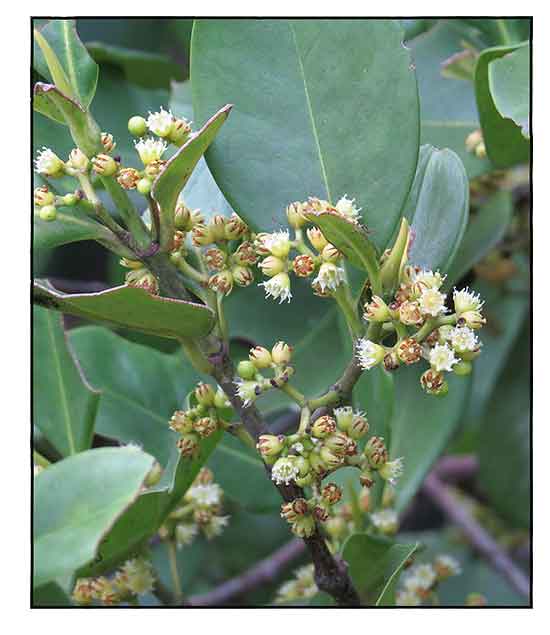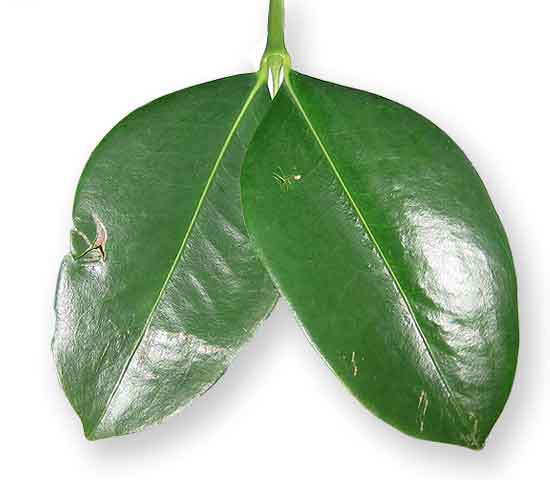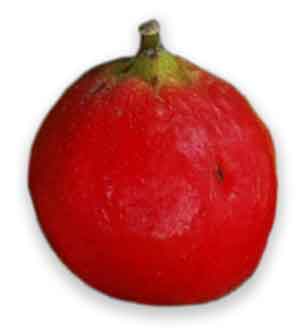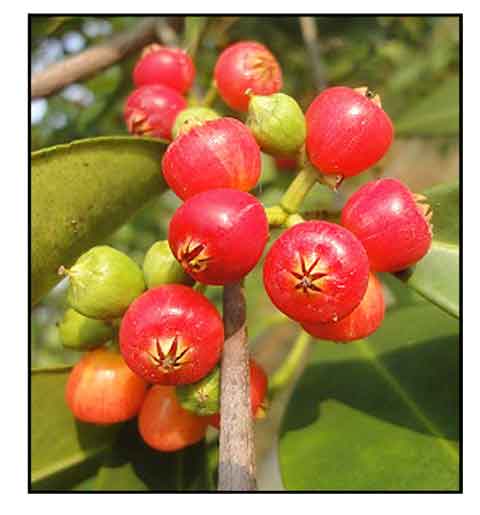 Gen info Gen info
- Carallia brachiata is a large tree in the family Rhizophoraceae.
- Etymology: The genus name Carallia derives from Karalli, an Indian name. The species epithet brachiata derives from Latin, meaning "branched at right angles" or "arm-like", referring to the branching of the flowering shoot. (2)
Botany
• Usually a tree with a single trunk up to 50 m tall, but in Singapore, it is usually only about 20 m tall. Trunk: Bark is brown, and its twigs are conspicuously swollen at the nodes. Foliage: Opposite, stalked leaves have leathery leaf blades that are usually oval or drop-shaped, and 4–15 by 2–10 cm, with rather sharp tips. Its leaf blades are dark green above, and yellow-green with brown spots below. Flowers: Flowering shoots are divided into two equal, or three branches, and 1–6 cm long. Its flowers are stalkless, or shortly-stalked, white or pale-greenish, 3 mm long, and develop from the angles of leaves. Fruits: Fruits are round berries up to 7 mm wide, and ripen from pink to red. Their fleshy pulp contain many seeds. (2)
Distribution
- Native to the Philippines. (1)
- Also native to Andaman Is., Assam, Bangladesh, Bismarck Archipelago, Borneo, Cambodia, China South-Central, China Southeast, East Himalaya, Hainan, India, Jawa, Laos, Lesser Sunda Is., Madagascar, Malaya, Maluku, Myanmar, Nepal, New Guinea, Nicobar Is., Northern Territory, Queensland, Solomon Is., Sri Lanka, Sulawesi, Sumatera, Thailand, Vietnam, Western Australia. (1)
- In primary and secondary forests, in lowlands up to 1,800 m altitude, and on the margins of freshwater swamp forests. (19)
 Constituents Constituents
- In a study of stem bark and leaves for antioxidant activity, the methanol extract of stem bark showed highest TPC value (262.73 mg GAE/g extract), while the ME of leaf showed highest TFC value (45.46 mg QE/g extract). Phenolic content of bark was higher than the leaf extract, and the flavonoid content was marginally higher. (see study below) (3)
-
Phytochemical screening of petroleum ether, ethyl acetate, and methanol extracts of Carallia brachiata stem bark
yielded sterols or triterpenoids, flavonoids, phenols, tannins, carbohydrates, fixed oils and fats. (see study below) (4)
- Phytochemical screening of ethyl acetate (EA), methanol (M), and aqueous (A) extracts of leaves yielded: Alkaloids ++ (EA, M, A), glycosides ++ (EA, M, A), phenolic compounds and tannins ++ (EA, M, A), flavonoids ++ (EA, M, A), carbohydrates ++ (EA, M, A), proteins ++ (EA, M), saponins ++ ( M, A), gum ++ (A), with absence of fats and oils, and lignins.
(5)
- Study of C. brachiata stem and bark isolated furofuran lignans (−)-(7′′R,8′′S)-buddlenol D (1) and (−)-(7′′S,8′′S)-buddlenol D (2). (see study below) (9)
 - Two new catechin derivatives, carabrachiatanins A and B (1,2) and seven known proanthocyanidins (3-9) were isolated by bioguided fractionation. (see study below) (12) - Two new catechin derivatives, carabrachiatanins A and B (1,2) and seven known proanthocyanidins (3-9) were isolated by bioguided fractionation. (see study below) (12)
- Study of leaves isolated a new megastigmane diglycoside,
3-hydroxy-5,6-epoxy-β-ionol -3-O-β-apiofuranosyl-(1→6)-β-glucopyranoside (1), along with 29 known compounds consisting of two megastigmanes, one 1,2-dithiolane derivative, seven aromatic compounds, five condensed tannins, 12 flavonoids, and two glyceroglycolipids. (15)
- In a study for proximate composition and mineral constituents, the species showed variable results in both parts.
Proximate analysis of leaf and fruit showed: moisture (1.47 and 6.73%), ash ( 14.87 and 3.42%), crude protein 13.59 and 10.9%), crude lipid (1.41 and 0.41%), crude fiber (18.87 and 12.82%), carbohydrate ( 59.79 and 65.74%) and total energy (306.2 and 310.25 Kcal/100g), respectively. Both parts are rich in micronutrients like Cu, Zn, and Fe. (17)
Properties
- Studies have suggested wound healing, antidiabetic, analgesic, antioxidant, hypolipidemic, anti-inflammatory, anti-MRSA, anti-adipogenic properties, radical scavenging, xanthine oxidase inhibitory, hepatoprotective properties.
Parts used
Leaves, bark.
 Uses Uses
Edibility
- Fruits and seeds are edible.
- Seeds contain an oil used as substitute for ghee in Karnataka, India. (4)
- Leaves are used to prepare tea. (3)
Folkloric
- No reported folkloric medicinal use in the Philippines.
- Leaves and bark are used for treatment of skin itches and septic poisoning.
- Bark used for treatment of cuts and wounds, oral ulcers, throat inflammation and stomatitis. (4)
- Decoction of leaves mixed with benzion, tumeric, and rice dust used for treatment of sapraemia. (5)
- In Vietnam, used for treatment of mouth ulcers, tongue sores, sore throat, and malaria.
- In Indonesia, decoction of stems drunk to restore stamina. Decoction of leaves drunk for fever accompanied by cough.
- In India, juice from macerated leaves used for treatment of fevers. Pulverized bark is rubbed on the body for treatment of smallpox. Leaves and bark used for treatment of septic poisoning and itches. (18)
Others
- Wood: Yield
- Construction: Used for various construction needs viz. cabinetry, interior finish, pallets, packing material, railway carriages, etc.
- Fuel: A good source of quality firewood and charcoal. (2)
Studies
• Antioxidant / Stem Bark and Leaf: Study evaluated the antioxidant activity of stem bark and leaf of C. brachiata using DPPH, ABTS, and FRAP assays. The methanol extract of stem bark showed highest TPC value (262.73 mg GAE/g extract), while the ME of leaf showed highest TFC value (45.46 mg QE/g extract). Phenolic content of bark was higher than the leaf extract, and the flavonoid content was marginally higher. The ME showed highest antioxidant activity for DPPH (13.06 µg/mL), ABTS (7.19 µg/mL), and FRAP assay (155.19 µM Fe2+/g). The stem bark showed greater antioxidant activity than the leaf. (see constituents above) (3)
• Wound Healing / Bark: Study evaluated ointment formulations of petroleum ether, ethyl acetate, and methanol extracts of Carallia brachiata stem bark for wound healing activity using excision and incision models in Wistar rats. The ethyl acetate and methanol extracts at 5% ointment formulation showed significant wound healing activity. Higher tensile strength in the incision wound model indicated enhanced collagen maturation. (see constituents above) (4)
• Antidiabetic / Antioxidant / Leaves: Study evaluated a hydro-alcoholiic extract (HAE) of C. brachiata leaves for antioxidant and antidiabetic activities in streptozotocin-induced diabetic rats at doses of 250 and 500 mg/kbw for 21 days. Results showed good hypoglycemic activity and diabetic rats and statistically significant antioxidant activity compared to standard drugs, quercetin and gallic acid. Antidiabetic activity was attributed to antioxidant plant phenolics/flavonoids. (6)
• Antidiabetic / Analgesic / Anti-Inflammatory / Leaves: Study of leaves extracts on experimental mice showed significant analgesic effect (p<0.01) on acetic acid induced writhing of mice compared to diclofenac standard. A single dose of ME of leaves 150 mg/kg intraperitoneally reduced blood cholesterol and triglycerides significantly (p<0.05). A 500 mg/kg fraction reduced blood glucose levels to 67, 63, 57, and 50% in 60, 120, 180, and 240 minutes. The MeOH extract at doses of 250 and 500 mg/kbw exhibited significant (p<0.05 and p<0.005) and dose-dependent inhibition of carrageenan induced paw edema. Studies were suggested to evaluate mechanisms of actions. (7)
• Anti-MRSA Activity / Analgesic / Anti-Inflammatory / Leaves: Study revealed the anti-MRSA (methicillin-resistant Staphylococcus aureus) activity of extract of C. brachiata. The capacity to inhibit MRSA's hemolytic properties was determined by culturing MRSA on blood agar. Results showed MIC of EA extract fraction against MRSA of approximately 2.5 mg/mL. (8)
• Anti-Inflammatory / Stem and Bark: Study of C. brachiata stem and bark isolated furofuran lignans (−)-(7′′R,8′′S)-buddlenol D (1) and (−)-(7′′S,8′′S)-buddlenol D (2). Compounds 1 and 2 inhibited nitric oxide (IC50 9.25 and 8.43 micromolar, respectively, and prostaglandin Es (IC50 6.15 and 5.70 micromolar, respectively, in lipopolysaccharide-induced RAW264.7 cells. On western blotting, both compounds suppressed LPS-inducible NO synthase and cyclooxygenase-2 expression in a dose-dependent manner (0.3-30 micromolar). The 7′′,8′′-buddlenol D epimers demonstrated anti-inflammatory activities via p38 MAPK inhibition and has potential for anti-inflammatory therapies. (9)
• Antibacterial / Bark: Study evaluated bark of C. brachiata for antibacterial activity in gradient and single extraction methods against ten pathogenic bacterial strains. Acetone extract showed maximum antibacterial inhibitory activity against the 10 tested bacterial strains, with MIC and MBC of 12.5 mg/ml and 25 mg/ml towards Serratia marcescens. Study showed gradient extraction could give better results compared to single extraction in 95% ethanol. (10)
• Antiadipogenic Activity / Leaf and Stem: Study evaluated the antiadipogenic activity of ethanolic extract of C. brachiata stem (CS) and leaf (CL) on inhibition of adipogenesis in 3T3-L1 cells culture. Results showed during adipogenic differentiation, CS down-regulated gene expression of adipogenic transcription factors (PPARγ, C/EBPα, aP2, FAS, LPL, and SREBP1c. CL only suppressed SREBPO1c and aP2 genes. Accumulation of lipids was suppressed by CS. Results suggest the stem extract has better anti-adipogenesis effect than the leaf part via suppression of adipogenesis-related gene expression. Inhibition of lipid storage can decrease insulin resistance risk. (11)
• Carabrachiatanins / NO Production Inhibition: Study evaluated the NO inhibition activity of C. brachiata in LPS-activated RAW264.7 cells. Two new catechin derivatives, carabrachiatanins A and B (1,2) and seven known proanthocyanidins (3-9) were isolated by bioguided fractionation. All isolates significantly showed NO inhibition with IC50s ranging from 13.72 -34.28 µM. Compounds 7 and 8 inhibited NO production with IC50s of 16.31 and 16.53 µM, respectively, compared to dexamethasone with IC50 of 14.94 µM. (12)
• Gold Nanoisotrops / Leaves: Study reports on a rapid, cost-effective, eco-friendly, single-step method for synthesis of gold nanoparticles (AuNPs) using Carallia brachiata, and evaluated its catalytic application in the reduction of 4-nitrophenol. The catalytic activity of small, isotropic AuNPs prepared using basic aqueous extract was more effective than nanoanisotrops. (13)
• Xanthine Oxidase Inhibition / Radical Scavenging / Proanthocyanidins: Antioxidant-guided separation of bark isolated a new A-type trimeric proanthocyanidin, carallidin (1), along with mahuannin A (2) and p-hydroxy benzoic acid (3). Compounds 1 and 2 exhibited radical scavenging activity against DPPH (IC50 102 and 182 µM) and superoxide radical (IC50 1.47 and 9.74 µM). Compounds 1 and 2 also inhibited xanthine oxidase with IC50s of 12.09 and 16.0 µM. (14)
• Hepatoprotective against Carbon Tetrachloride Toxicity / Bark: Study evaluated ethyl acetate and methanol extracts of C. brachiata bark against CCl4-induced hepatotoxicity in rats at dose levels of 250 and 400 mg/kbw. The EA extract showed more significant lowering of biochemical parameters viz. SGPT, SGOT, ALP and serum bilirubin, almost similar to standard silymarin. (16)
• Comparative Study of Nutrient and Mineral Composition / Leaf and Fruit: In a study for proximate composition and mineral constituents, the species showed variable results in both parts. Proximate analysis of leaf and fruit showed: moisture (1.47 and 6.73%), ash ( 14.87 and 3.42%), crude protein 13.59 and 10.9%), crude lipid (1.41 and 0.41%), crude fiber (18.87 and 12.82%), carbohydrate ( 59.79 and 65.74%) and total energy (306.2 and 310.25 Kcal/100g), respectively. Both parts are rich in micronutrients like Cu, Zn, and Fe. (see constituents above) (17)
Availability
Wild-crafted.
|

![]()





 - Two new catechin derivatives, carabrachiatanins A and B (1,2) and seven known proanthocyanidins (3-9) were isolated by bioguided fractionation. (see study below) (
- Two new catechin derivatives, carabrachiatanins A and B (1,2) and seven known proanthocyanidins (3-9) were isolated by bioguided fractionation. (see study below) ( Uses
Uses